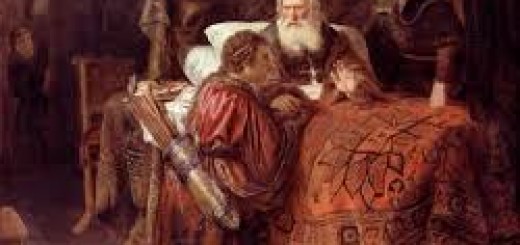By Avner Friedmann
The Mishnah[1] tells us that ten things were created at twilight between Friday and the Shabbat of Creation, all of which were both physical and spiritual at once. To achieve their spirituality they were created near the onset of Shabbat and were “on hold” awaiting their proper time to appear and demonstrate their physical and their spiritual dimensions, to assist the Jewish people in strengthening their faith and to bring them closer to Hashem. Among these things was the Moshe’s staff.
The Midrash[2] tells us that this staff was made of sapphire while other sources say it was wooden. Upon it was engraved the explicit name of Hashem and also an acronym of the ten plagues. It was instrumental in performing wonders, such as those that occurred with the burning bush, the plagues in Egypt, the splitting of the Red Sea and bringing water out of the Rock. This staff was originally given by HaShem to Adam. It then became a “spiritual spine”, so to speak, in the hands of certain Tzaddikim through the generations. Adam bequeathed it to Enoch, who gave it to Noah, who gave it to his son Shem. Abraham then received it from Shem and gave it to his son Yitzchak, who gave it to Yaakov. When Yaakov went to Egypt with his family he took the staff with him and later passed it on to his son Yosef. After Yosef passed away, Pharaoh confiscated it and it was placed in his palace. Yitro, who at the time was one of Pharaoh’s advisers, saw and desired it. When he returned home to Midian, he took the staff with him.
Yitro realized that whoever could interpret the writings on the staff would be the redeemer of the Jewish people and take them out of Egypt. He stuck it into the ground of his garden and once he did so, the staff could no longer be pulled out by anyone. Yitro made an announcement that he would give his daughter, Tzipporah, as a wife to anyone who could uproot the staff. All the mighty men of Midian tried to do so and failed. When Moshe came to Midian, Yitro imprisoned him and left him to die in a pit without food and water. However, for ten years, unbeknown to Yitro, his daughter Tzipporah secretly fed Moshe. Later, she asked her father, “What would be the fate of this man in the pit?” Yitro assumed that he must have died, but Tzipporah said to him, “Surely you have heard that his nation is known for having miracles happening to them”. Moshe was taken out of the pit and as he was praying and thanking Hashem, he noticed the staff in the garden. He approached it; saw HaShem’s name carved upon it and pulled it out with ease. Yitro was taken aback when he saw the staff in Moshe’s hand. He exclaimed, “This man will take Israel out of Egypt” and he gave Moshe his daughter Tzipporah as a wife. Tzipporah was a very righteous woman who followed the ways of Hashem.
For many years, as Moshe shepherded his father-in-law’s flock, he was in possession of the staff. His experience as a shepherd became his “proving ground” for his destiny as the future “Shepherd of Israel”. One day, while leading the flock near Mount Chorev (Sinai), HaShem appeared to him for the first time from the burning bush and appointed him to be the redeemer of Israel. The Torah tells us[3] that Hashem performed a miracle for Moshe: “Hashem said to him, ‘What is in your hand?’ and he said, ‘A staff.’ He said, ‘cast it to the ground’, and he cast it to the ground and it became a snake. Moshe fled from it. Hashem said to Moshe, ‘Stretch out your hand and grasp its tail.’ He stretched out his hand and grasped it tightly and it became a staff in his palm.” according to the Zohar[4], the word ‘snake’, which refers to the evil snake of Gan Eden, was carved on the other side of the staff at that time.
Through this miracle Hashem taught Moshe a fundamental lesson. He showed him that even the staff which represents purity, holiness and humility, can fall to the ground and can turn into a snake. However, it can always turn back and become holy again. In doing so, HaShem demonstrated that though, in essence, a Jew who is good, he can fall. However, he can also return to his good roots. This principle applies to the nation of Israel as a whole as well. Since, ultimately they are a portion of HaShem from above, even if they find themselves in the lowest place, such as Egypt, they can nonetheless be holy again. Falling, even many times, but getting up and learning from our experience, is part of the process that HaShem created to bring us closer to Him, as it is written[5]: “For though the righteous one may fall seven times, he will arise, but the wicked ones will stumble through evil.”
Through this experience Hashem also showed Moshe that evil is not an independent power in and of itself, heaven forbid. Ultimately, its true source is also in the good, in that it was created to allow us to have free will and have the opportunity to come close to HaShem through our own volition. In essence, it is like HaShem’s staff and helps us follow the right path. It tempts us to go contrary to HaShem’s will and to pursue the temporary pleasures of this world for their own sake, and our challenge is to resist and overcome these temptations. The word staff in Hebrew (מטה) comes from the word “to divert” or “to sway”. Its true purpose is to help sway the hearts of Israel towards Hashem.
The staff demonstrated the power of holiness over evil. On the one hand, it had the ability to be in the palace of Pharaoh, the place of ultimate impurity and evil, but on the other hand, it had the power to take us out of the defilement of Egypt, and bring us up to the level of Adam before the sin of the tree of the knowledge of good and evil, as we achieved at Mount Sinai. We will ultimately achieve this state again in the time of Moshiach when evil will be abolished forever, may it be speedily in our times, Amen.
[1] Avot 5:6.
[2] Sources for this drasha were gathered from: Yalkut Shimony Shemot Perek 4, 247, and 173. Pirkei DeRabbi Eliezer Perek 40. Shemot Rabah Parasha 8:3. Zohar Teruma 163a. Netivot Shalom Pesach- The signs. Pri Etz Armoni Shemot. R’ Baruch Rosenblum’s lecture at Bnei Brak from Midrashim.
[3] Shemot 4:2-3.
[4] Zohar Chadash Beshalach 38a-38b.
[5] Provebs 24:16.






















